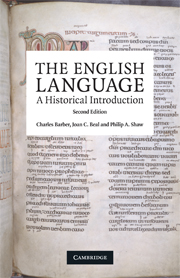Book contents
- Frontmatter
- Contents
- List of figures
- Preface to the second edition
- Preface to the first edition
- Map showing the counties of England
- 1 What is language?
- 2 The flux of language
- 3 The Indo-European languages
- 4 The Germanic languages
- 5 Old English
- 6 Norsemen and Normans
- 7 Middle English
- 8 Early Modern English
- 9 Late Modern English
- 10 English as a world language
- 11 English today and tomorrow
- Notes and suggestions for further reading
- Bibliography
- Index
Preface to the second edition
- Frontmatter
- Contents
- List of figures
- Preface to the second edition
- Preface to the first edition
- Map showing the counties of England
- 1 What is language?
- 2 The flux of language
- 3 The Indo-European languages
- 4 The Germanic languages
- 5 Old English
- 6 Norsemen and Normans
- 7 Middle English
- 8 Early Modern English
- 9 Late Modern English
- 10 English as a world language
- 11 English today and tomorrow
- Notes and suggestions for further reading
- Bibliography
- Index
Summary
In revising and updating Charles Barber's The English Language: a Historical Introduction, we have tried to interfere as little as possible with the overall tone and design of what has been a very popular and successful introductory textbook. Some revision was needed because of the advances of scholarship and opening up of new fields of research in the last decade of the twentieth century. This is particularly evident in chapters 9, 10 and 11: the study of Late Modern English gained momentum in the 1990s, the diversity of world Englishes has received much more attention in this period; and, of course, we are now in a position to review the twentieth century as a whole. In studying pre-modern languages, we are increasingly aware of the difficulties of simplistic equations of ethnicity with language, and there is a renewed emphasis on direct study of the epigraphic and manuscript records of early languages, along with increasing use of electronic corpora and computational approaches.
There has been some debate in recent years about whether it is appropriate to publish a ‘history of English’, given that there are many Englishes and many histories. In our experience of teaching an introductory module on this subject to first-year undergraduates, they need and appreciate a narrative which ‘tells a story’ simply and clearly without ‘dumbing down’ or glossing over difficulties.
- Type
- Chapter
- Information
- The English LanguageA Historical Introduction, pp. ix - xPublisher: Cambridge University PressPrint publication year: 2009



